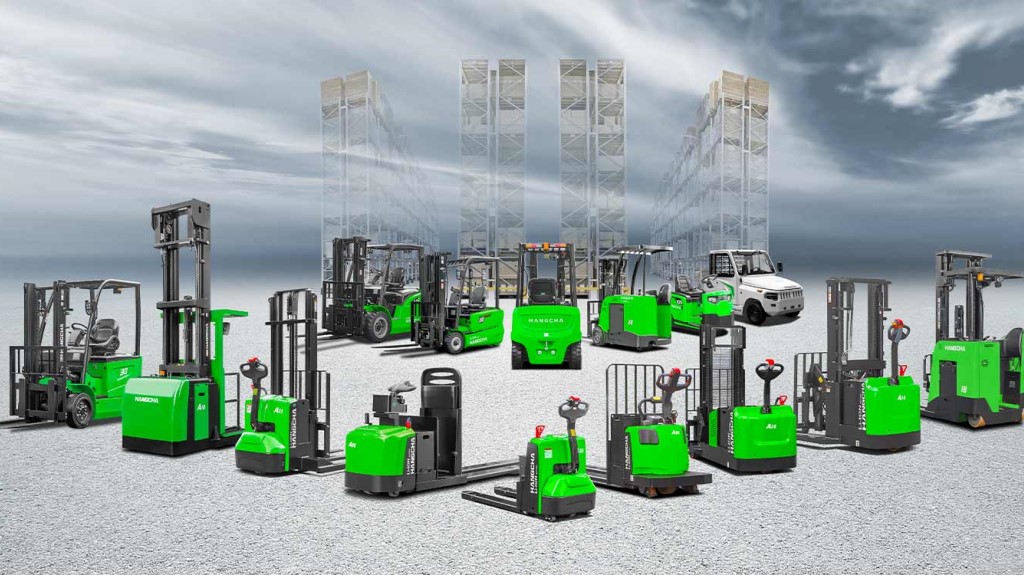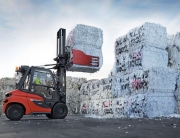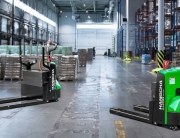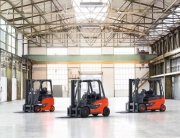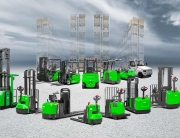Whether you’re expanding your fleet or buying your first forklift, deciding between new and used forklift sales can be a challenge. With different price points, features, and long-term costs to consider, it’s important to understand what you’re really getting and what fits your business best. In this guide, we’ll break down the key factors that influence forklift pricing, weigh the pros and cons of new versus used forklifts, and help you make a smart, informed purchase.
- Factors that Affect Forklift Pricing
- Advantages and Disadvantages of Buying a Used Forklift
- Advantages and Disadvantages of Buying a New Forklift
- New or Used Forklift? How to Make Your Decision
- Where to Buy New and Used Forklifts
Ready to explore quality new and used forklifts? Contact Ri-Go Lift Truck today for expert advice and a wide selection of machines to match your needs and budget.
New or Used Forklift Sales
1. Factors that Affect Forklift Pricing
Asking “How much does a forklift cost?” is a bit like asking how much a car costs; it depends on many different factors.
Think About Buying a Car
If you asked a car dealer about the price of a vehicle, they wouldn’t be able to give you one simple answer. Instead, they would likely ask you several important questions, such as: “What type of car are you looking for?”, “What options would you like?” or “What kind of warranty do you want?”
Like cars, the cost of a forklift depends on the type, size, power, age, and features you’re looking for. New forklifts with advanced features will cost more, while used models may offer savings, but with different benefits and trade-offs.
Let’s take a closer look at the main factors that affect the price of both new and used forklifts.
Factors That Affect Forklift Pricing

Electric forklifts have a higher upfront cost but will give you a lower total cost of ownership.
There are several important factors that can change the price of a forklift. The type of forklift you need, along with its features and size, will have a big impact on the final cost.
Type of Fuel
Forklifts can run on three main types of fuel: electricity, liquefied propane gas (LPG), and diesel. Each fuel type affects the price in different ways.
- Electric Forklifts:
Electric forklifts usually have the highest upfront cost. This is because the large industrial battery they use is included in the purchase price. The battery also acts as a built-in fuel source, so you are paying for the power in advance. - Diesel Forklifts:
Diesel forklifts are typically more expensive than LPG models, but they are cheaper than electric ones. They cost more than LPG forklifts because they use heavy-duty parts that are built to handle the tough demands of diesel engines. - LPG Forklifts:
LPG-powered forklifts are often the least expensive option to buy. In addition to their lower purchase price, the cost of LPG fuel is also lower. In some cases, LPG can cost up to 50% less per unit than diesel fuel.
Choosing the Right Fuel Type
The best fuel type depends on your budget, how often you use the forklift, and where you use it. Think about both the upfront cost and the long-term fuel expenses when making your decision.
Type of Tire
Forklifts can be equipped with different types of tires, depending on the model and where they will be used. The main types include cushion tires, air-filled pneumatic tires, and solid foam-filled tires.
Specialized Tire Options:
There are also special tire options available. For example, razor-siped tires are made for slippery conditions, and non-marking tires are used in places where it is important to keep the floors clean.
How Tire Type Affects Cost:
The type of tire you choose can affect the price of the forklift. Foam-filled, air-filled, or solid rubber tires all come with different costs. Basic black cushion and air-filled pneumatic tires are usually included as standard on most models.
Upgraded Tires Cost More:
If you want upgraded tires, such as foam-filled tires or a dual-drive setup, you should be ready to spend more. These upgrades can cost anywhere from $1,500 to over $4,000.
Lift Capacity
The lift capacity of a forklift plays a big role in how much it costs. Forklifts that can lift heavier loads need stronger materials and more powerful parts. This makes them more expensive to build and buy.
Bigger Capacity Means Higher Price:
A forklift with a higher weight limit will usually cost more. For example, a forklift that can lift 10,000 pounds might cost almost twice as much as one that can lift 5,000 pounds.
Keep Capacity in Mind:
As you shop for a forklift, think about how much weight you need to lift. Choosing the right capacity can help you balance performance and cost.
Size of Mast:
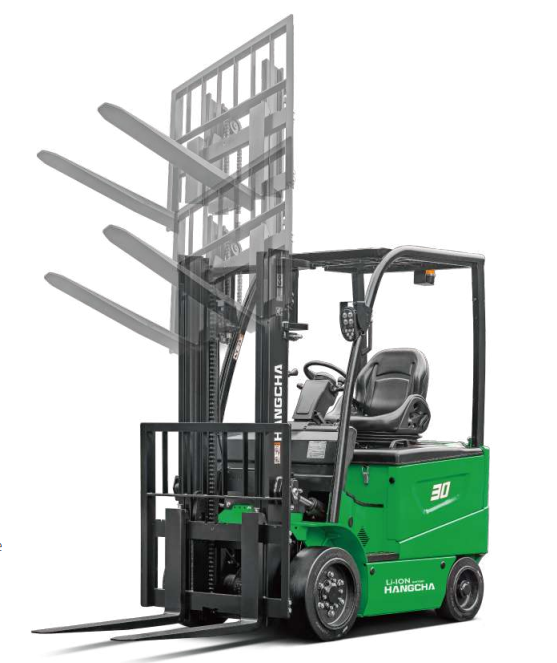
Forklifts with taller masts will cost more than those with standard or shorter ones.
In the forklift industry, a three-stage mast that reaches 189 inches is considered the standard. However, there are many different mast sizes and styles available depending on your needs.
Shorter Masts for Tight Spaces:
Some forklifts have shorter masts that are designed to work in small or tight areas. These are useful in places like semi-trailers or warehouses with low ceilings.
Taller Masts for High Racking:
Other forklifts come with taller masts that can lift loads up to 25 feet or more. These are often used in warehouses with tall storage racks.
Taller Masts Cost More:
In general, the taller the mast, the more materials are needed to build it. This usually means that forklifts with taller masts will cost more than those with standard or shorter ones.
Hydraulic System
Most forklifts come with a standard hydraulic system that includes a 3-way valve and a single internal hose. This basic setup is included in most models.
What the Standard System Does:
The standard hydraulic system allows the forklift to do three main things. It can lift loads, tilt the mast, and move a side shifter from side to side.
When You Need Extra Hydraulic Power:
If you want to use special attachments like a fork positioner, paper roll clamp, or slip-sheet attachment, you will need an extra hydraulic valve section. These attachments require more control and power than the standard system can provide.
More Features Mean Higher Cost:
Adding these extra hydraulic features will make the forklift more useful, but it will also increase the overall cost. Be sure to consider whether you need these features before you buy.
Other Features and Accessories
The more features and custom parts you add to a forklift, the more it will cost. Forklifts with basic setups are more affordable, while those with special upgrades will have a higher price.
Common Extras That Raise the Price:
Here are some popular features that can increase the cost:
- Cab with Heater: Adding a full cab to protect the operator and keep them warm costs extra.
- Custom Paint: If you want the forklift painted in your company’s colours, expect to pay more.
- Specialized Use: Features like cold storage packages for freezers or safety ratings such as ES, EE, and EX for dangerous environments will also raise the price.
Accessories and Safety Features:
Extra accessories and safety tools can also affect the price. Some examples include:
- Blue and red warning lights
- LED headlights
- Comfortable suspension seats
These upgrades help improve safety and comfort, but they usually come with an extra cost. Many of these features can cost several hundred dollars or more.
Extra Things to Consider When Buying a Used Forklift
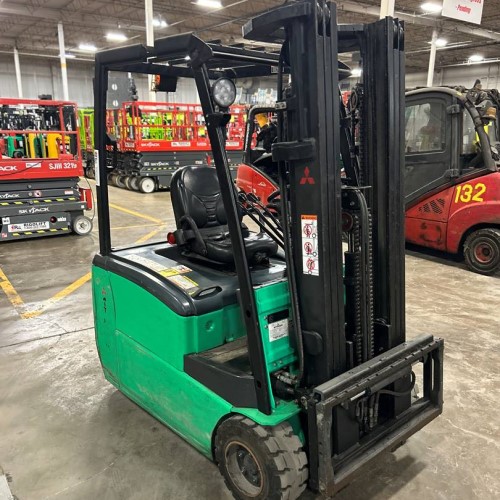
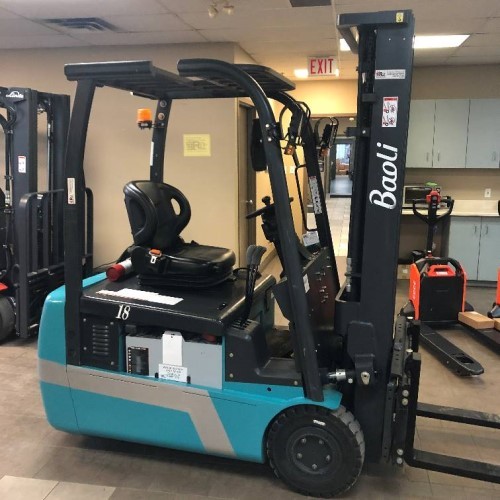
Try to choose a forklift that is less than 10 years old for the best value.
When you buy a used forklift, there are more things to think about compared to buying a new one. These extra factors can affect the price and value.
Age of the Forklift:
Like with cars, newer forklifts usually cost more than older ones. Older machines may have outdated features or need more maintenance. Try to choose a forklift that is less than 10 years old for the best value.
Operating Hours:
Forklifts track use by hours, not Kilometers. As a rule, 1 hour on a forklift is similar to 20 kilometers in a car.
So, a forklift with 5,000 hours has been used about as much as a car with 100,000 Kilometers.
But hours aren’t everything. A forklift with low hours used in a tough environment (like a chemical plant or Scrap yard) may be in worse shape than one with more hours used gently in a dry clean warehouse on flat concrete floors and never outside.
Condition of the Forklift:
Where and how a forklift was used before can change its condition and price. Some work environments can cause more damage, such as:
- Near salt water: This can cause rust on metal parts.
- Cold areas: Cold can make engine and hydraulic seals crack over time.
- Humid locations: Moisture can damage electrical systems.
- Outdoor use: Weather can lead to rust and wear on parts.
Ask about the type of conditions that the forklift was used in before making your decision.
How Thorough the Seller Is:
Some sellers sell forklifts “as-is,” meaning they don’t check or repair anything. These are cheaper and can be found on sites like eBay or Craigslist, but they may have problems like rust, bald tires, or broken parts.
At Ri-Go Lift, we meticulously inspect every used forklift to make sure it works properly before it’s sold.
Attachments:
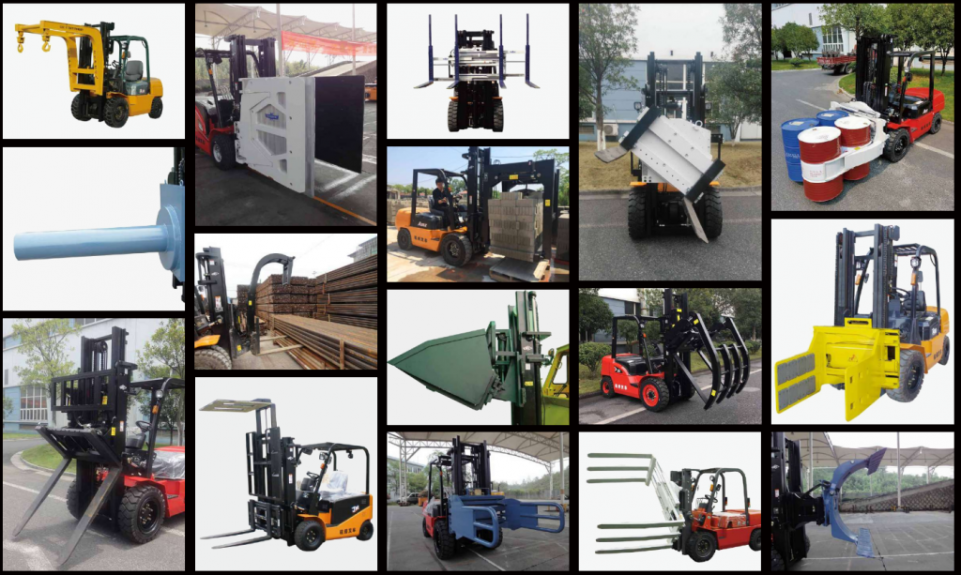
Forklift attachments can increase the price.
Forklifts often come with a side shifter, but others may include extra tools like:
- Paper roll clamps
- Box clamps
- Special add-ons
These extras can increase the price by thousands of dollars. If you don’t need the attachment, ask the seller if they’ll sell the forklift without it to save money.
Supply and Demand:
The market affects pricing. Common forklifts like 5,000 lb. cushion tire models are usually easier to find and cost less. Heavier or less common models may cost more simply because they are harder to find.
Also, timing matters:
- Forklifts with outdoor tires may cost more in the spring.
- Cab models are more popular (and expensive) in winter.
Buying during the off-season can save you money.
Warranty Options:
Used forklifts often have no warranties. Here are some types of warranties you might see:
- As-Is: No warranty, but cheaper.
- Short-Term: 30 or 60 days for parts and labour.
- Powertrain: 6-month coverage for the engine and transmission.
Warranty costs range from a few hundred dollars to $2,500 or more. If buying from another province, remember that many sellers will not offer a warranty due to service limits.
Paint Job:
A fresh paint job can raise the value. This is important in workspaces where paint chips are a problem, such as food processing companies that have strict hygiene requirements. It can also help keep the forklift in good shape and encourage better care by workers. New paint usually costs between $1,000 and $2,000.
Don’t Forget to Negotiate:
Like used cars, forklift prices are flexible. Ask about extras like:
- New tires
- Free paint job
- Upgraded attachments
- Free shipping
These bonuses can save you hundreds or even thousands of dollars.
2. Advantages and Disadvantages of Buying a Used Forklift
Why You Might Want to Buy a Used Forklift
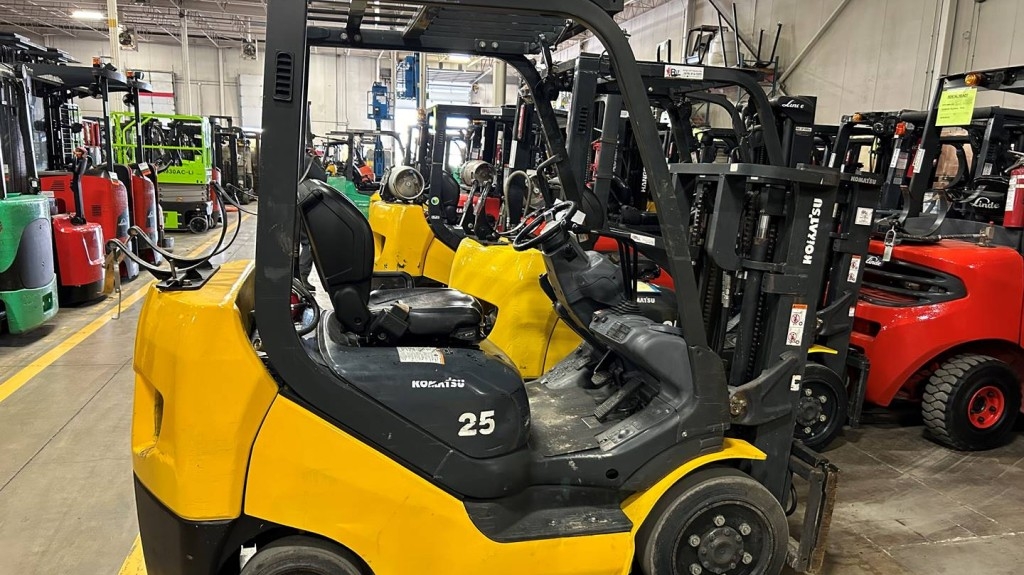
Used forklifts usually cost much less than new models.
While buying a new forklift has its benefits, there are also several good reasons to consider purchasing a used one.
Lower Cost:
Used forklifts usually cost much less than new models. This makes them a great option if you are trying to stick to a budget.
If you are renting a forklift and decide to buy it, some dealerships may offer a discount based on the rent you have already paid.
There may also be room to negotiate the price or ask for upgrades. These upgrades can include larger forks, new tires, or more advanced tools like a side shifting fork positioner instead of the standard side shifter.
Quicker Delivery:
Used forklifts are often available right away. In some cases, you can have the forklift delivered within just a few days.
If you are already renting the forklift and decide to buy it, the process is even faster. You could own the equipment the same day.
Faster Return on Investment:
The sooner you receive your forklift, the sooner you can start using it. This means you can begin making money from your investment more quickly. Getting the forklift into your operations right away helps you recover your costs faster and improves productivity.
The Downsides of Buying a Used Forklift
Used forklifts have many benefits, but it’s also important to understand the possible drawbacks.
Higher Maintenance Costs:
Used forklifts usually need more repairs because of wear and tear. Older forklifts or those with many hours are more likely to break down, which increases maintenance costs. Even when buying from a trusted seller, unexpected problems can still happen once the forklift is in use.
Shorter or No Warranties:
Used forklifts often come with short warranties, usually 30 to 60 days. Many dealers do not offer warranties for out-of-province buyers because servicing equipment far away is costly. If you want a longer warranty, expect to pay extra. Buying from a local, reputable dealer can help you get some warranty coverage, but it will still be much shorter than a new forklift’s warranty.
Limited Features and Configurations:
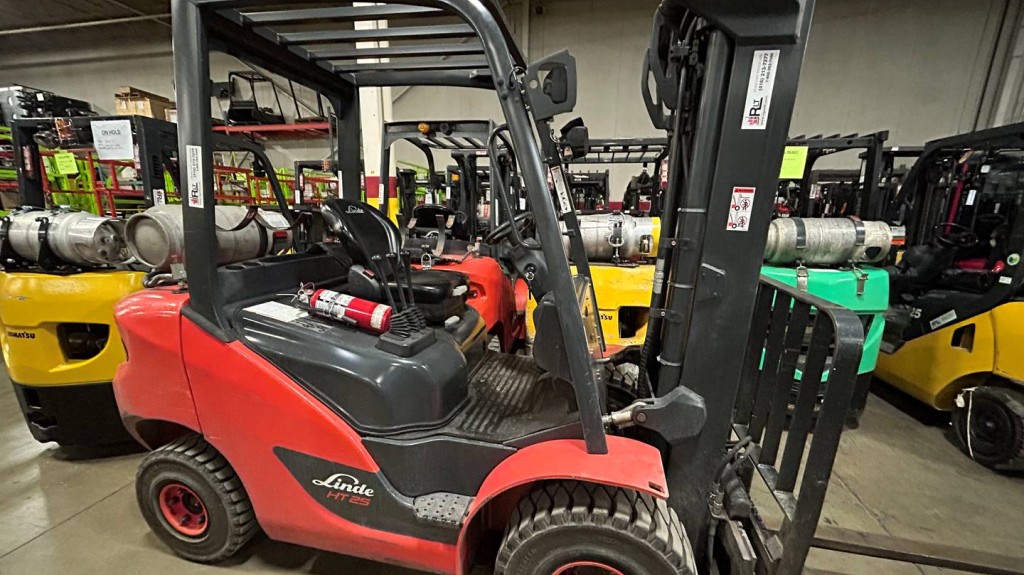
Special features are often not available for used forklift sales.
Finding the exact features and setup you need can be hard with used forklifts. Special features like heated cabs for cold weather, extra hydraulic valves for attachments, or hazardous environment ratings are often not available.
Also, the condition of used forklifts varies a lot depending on how much the seller has repaired or inspected them. Some are sold “as is” with little to no work done, and these may have rust, worn tires, or broken parts. Although these may seem cheap, they often need costly repairs.
Unknown History and Quality:
When buying used, you might not know the forklift’s full history. Without service records, you could buy equipment that:
- Was poorly maintained
- Worked in harsh environments like chemical or food plants
- Had repairs done by untrained people
- Has batteries (for electric forklifts) that were not cared for
To reduce risks, always ask for service records and learn how the forklift was used. If it worked in tough conditions, it might be better to look elsewhere.
Smaller Selection of Certain Models:
Some forklift types are rare in the used market because they are made in small numbers or built for special jobs. For example:
- 15,500 lb. cushion forklifts are less common.
- High-capacity forklifts with tall masts are usually custom orders and hard to find used.
- Specialty forklifts like narrow aisle or multi-directional models are also rare.
If you need these types, you may have to buy new.
Higher Shipping Costs:
If you find a good deal online, don’t forget to include shipping costs. Moving a forklift across provinces or the country can cost $1,000 to $5,000 or more. Oversized or heavy forklifts may need special permits, making shipping even more expensive. Always add shipping costs to the total price when buying online.
Lower Trade-In Value:
If you buy a used forklift and use it heavily, you will likely get only a small portion of your money back when you trade it in. For example:
- Small internal combustion forklifts (5,000 lb. capacity or less) trade in for about $800 to $2,000.
- Small electric forklifts trade in for $1,000 to $1,500 if the battery is included.
- Larger internal combustion forklifts (10,000 lb. or more) may trade for a few thousand dollars.
Scrap value depends on steel prices but is usually only a few hundred dollars. Newer forklifts with fewer hours keep more of their value when traded in.
Harder to Find Replacement Parts:
Older or rare forklift models can be difficult and expensive to repair because parts may be hard to find. Some parts might only come from overseas, adding to the cost and wait time. Before buying, check if parts are available and affordable. Be ready to pay more for both the parts and shipping.
3. Advantages and Disadvantages of Buying a New Forklift
Why You Might Want to Buy a New Forklift
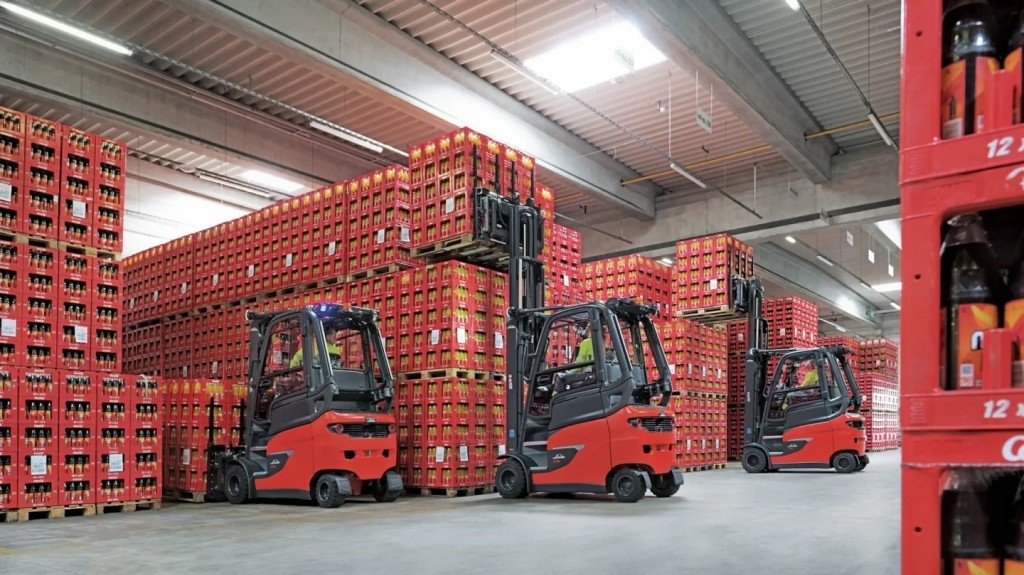
When you buy new, you get the latest features.
Buying a new forklift usually costs more, but there are several good reasons why it might be worth the investment.
Access the Newest Features:
Like cars, forklifts are always being updated with better technology. When you buy new, you get the latest features, which may include:
- Dashboards with built-in diagnostics
- Improved safety systems
- Better emissions control
- More comfortable seating and controls
These upgrades can make your forklift safer, easier to use, and more efficient, helping reduce downtime and worker injuries.
Pick the Right Mast Size:
If you need to lift products high or work in tight spaces like trailers or railcars, you may need a special mast size. Buying new allows you to choose the exact mast height that fits your job. This kind of customization is often hard to find with used forklifts.
Save on Shipping:
New forklifts usually come from local dealerships, so you only pay for short-distance delivery or pickup. This makes shipping costs lower and more predictable.
When buying used online, you may need to ship the forklift from far away, which can add thousands of dollars to the total cost. If possible, picking up the forklift yourself from the dealer can save you even more money.
Get a Longer Warranty:
Most new forklifts come with a warranty that lasts 12 to 36 months or covers up to 2,000 hours of use. Hangcha Canada offers incredible extended warranties, including a 10-year or 20,000-hour warranty on lithium-ion battery packs for select models.
In comparison, used forklifts usually come with shorter warranties—often just 30 to 60 days, or none at all. A longer warranty gives you peace of mind and protection from unexpected repair costs.
Higher Trade-In Value Later:
A newer forklift with lower hours is worth more when you trade it in. For example, a forklift that is 5 years old with 5,000 hours will usually be worth more than one that is 10 years old with 10,000 hours.
If you plan to trade in your forklift in the future, buying new can give you a better return, as long as the machine is well cared for and not used in harsh environments.
The Downsides of Buying a New Forklift
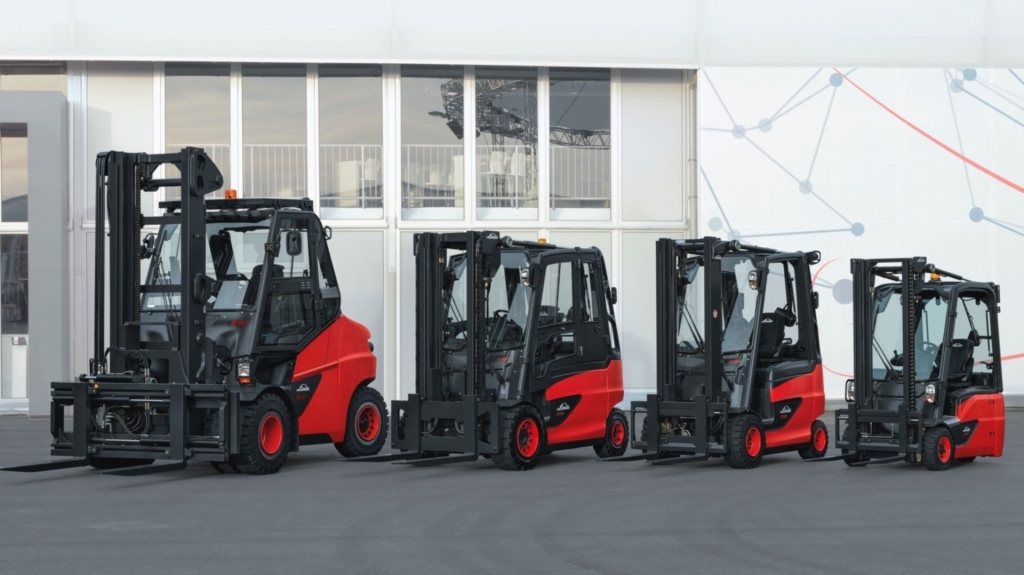
Like a new car, a forklift starts to lose value as soon as it is delivered.
While there are many benefits to buying a new forklift, there are also some disadvantages that are important to consider.
Higher Upfront Cost:
The biggest downside to buying new is the price. As mentioned earlier, new forklifts cost much more than used ones.
You also need to consider depreciation. Like a new car, a forklift starts to lose value as soon as it is delivered. If you plan to keep the forklift for many years, this drop in value might not matter as much. But if you plan to sell or trade it later, depreciation could affect your return.
Longer Wait Times:
When you buy a new forklift, you usually have to wait before it is delivered. This is because the manufacturer needs time to build and ship your specific model.
Wait times can range from a few weeks up to 18 weeks or more. The delay depends on:
- How busy the manufacturer is
- How many orders are they handling
- Any custom features you requested
If you need equipment right away, waiting for a new forklift might not work for your business.
Not Available Right Away:
If you are in urgent need of a forklift, a used model may be a better choice because it is available immediately.
However, some dealers offer rental forklifts at a lower cost while you wait for your new one to arrive. This can help keep your operations running in the meantime.
4. New or Used Forklift? How to Make Your Decision
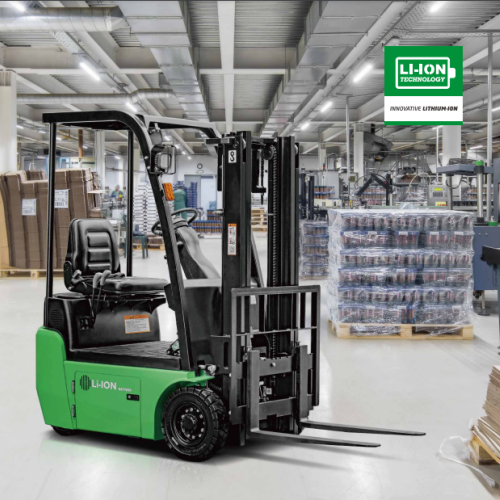
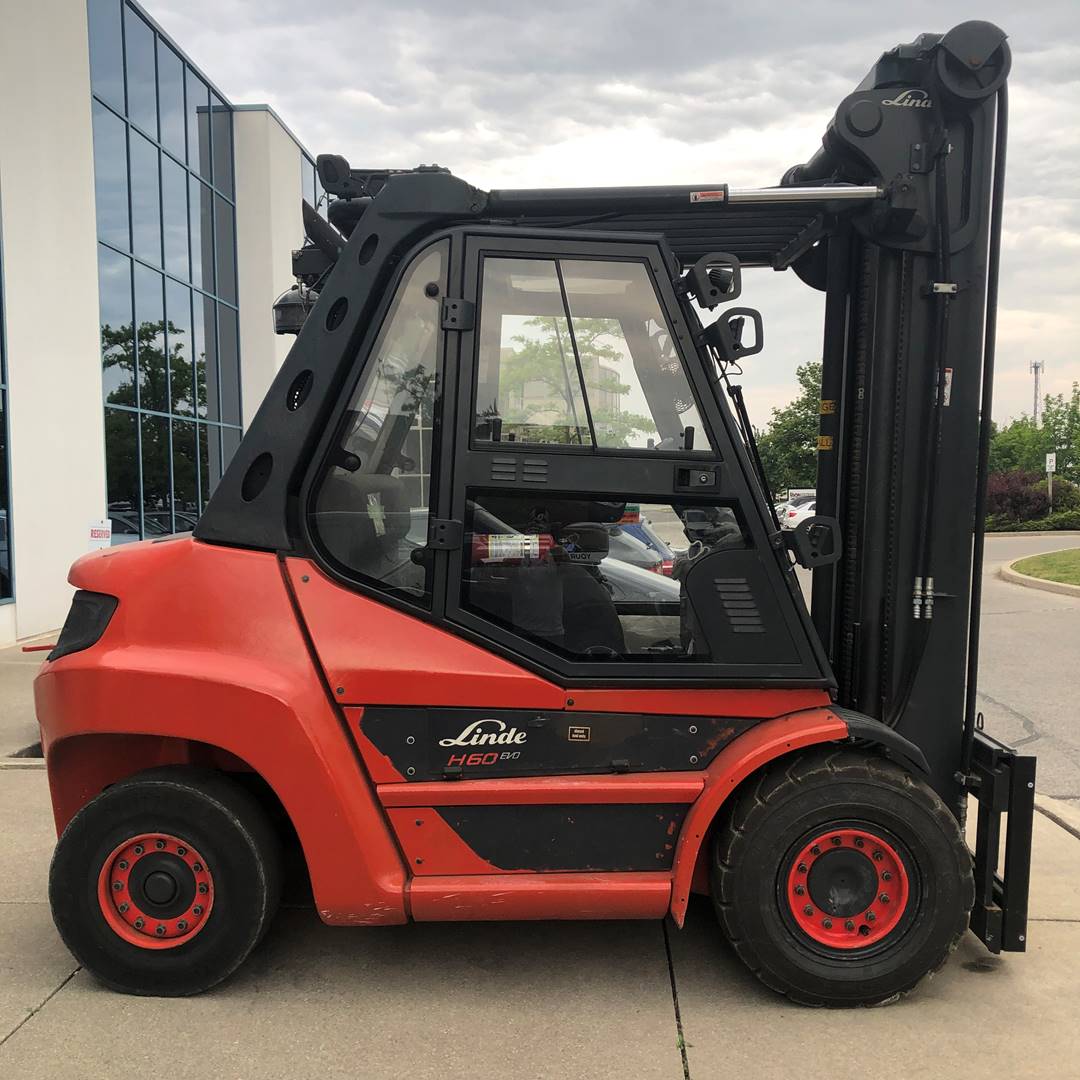
Used Forklift Sales: Figure out what kind of forklift fits your operation.
Now, let’s put everything together and create a step-by-step plan to help you choose the right forklift based on your needs and budget.
Key Questions to Ask Yourself
To make the best choice, ask these questions:
- What do I need the forklift for?
- How long will a new or used forklift last for my work?
- Does this option make financial sense?
What Do You Need?
The first step is to figure out what kind of forklift fits your operation.
Capacity:
- How much weight does your forklift need to lift?
- Do you need a smaller forklift (around 3,000 lbs) for light tasks?
- Or a heavy-duty forklift (up to 30,000 lbs) for tough jobs?
Remember, high-capacity forklifts are harder to find used.
Mast Size:
What mast height do you need?
- Common mast sizes range from about 131 inches to 240 inches.
- Standard forklifts usually have a 189-inch mast.
- Specialty mast sizes are harder to find used.
Heavy Use:
How many hours a day will the forklift be used?
- Using a forklift for 4 or more hours daily counts as heavy use.
- For heavy use, newer forklifts with fewer hours are better.
- Higher-capacity forklifts with many hours need extra caution.
- Aim for forklifts with around 5,000 hours for good value.
Environment:
Will the forklift work around chemicals, dust, or dirt?
- Tough environments may require newer or well-maintained forklifts.
- Will the forklift be used indoors or outdoors?
- Outdoor forklifts may need cabs; indoor forklifts may need to fit through doorways.
- Electric forklifts are better for places sensitive to emissions.
What Attachments Do You Need?
- Most forklifts come with a standard sideshifter.
- Special attachments like fork positioners or clamps may cost extra.
- Make sure the forklift has the right hydraulic setup for any special attachments.
- Using the wrong attachment can reduce lifting capacity or increase costs.
What About Batteries and Chargers?
- New electric forklifts usually don’t come with batteries or chargers included.
- Batteries cost between $5,000 and $12,000 new.
- Used forklifts may include older batteries or none at all.
- Ask about battery age, make, and condition. Batteries last about 5 years.
- New chargers cost $3,000 to $6,000; used ones are cheaper but less common.
How Long Will a Forklift Last?
- Most forklifts last about 10,000 hours with good maintenance.
- Electric forklifts often last longer than gas or diesel models.
- A forklift’s history and how well it was maintained are very important.
- Consider the work environment, hours used, maintenance, and operator care.
- Heavy-use and high-capacity forklifts usually wear out faster.
What to Look for When Buying Used:
- Age: Look for forklifts at least five years old to save money.
- Hours: Check usage hours, not just key hours. Usage hours show actual work done.
- Application History: Avoid forklifts exposed to salt water, extreme cold, moisture, or heavy outdoor use.
- Condition: Inspect forks, chains, safety features, mast, tires, engine, and check for leaks.
- Maintenance Records: Ask for maintenance history to avoid surprises.
- Avoid Discontinued Models: Parts may be hard to find.
How Long Will YOUR Forklift Last?
Think about how your environment and maintenance will affect your forklift’s life. Be honest about your operating conditions. If unsure, ask a local dealer for advice. They can help estimate your forklift’s lifespan and guide you in choosing new or used.
Does It Make Financial Sense?
The last step is figuring out if it’s cheaper to keep repairing your forklift or buy a new one. This is called the forklift’s economic life.
Economic life is when repair costs become higher than buying a new forklift. Knowing this helps you get the best return on your investment.
Example: Calculating Economic Life
Suppose you find a used 5,000 lb forklift with 7,000 hours. You think it’s priced well. You estimate the forklift will last 9,000 hours in your work environment. That leaves 2,000 hours of use left.
If you use it 4 hours a day, 5 days a week, you’ll reach 9,000 hours in about 1.9 years. This kind of calculation helps you decide if the forklift is worth buying.
5. Where to Buy New and Used Forklifts
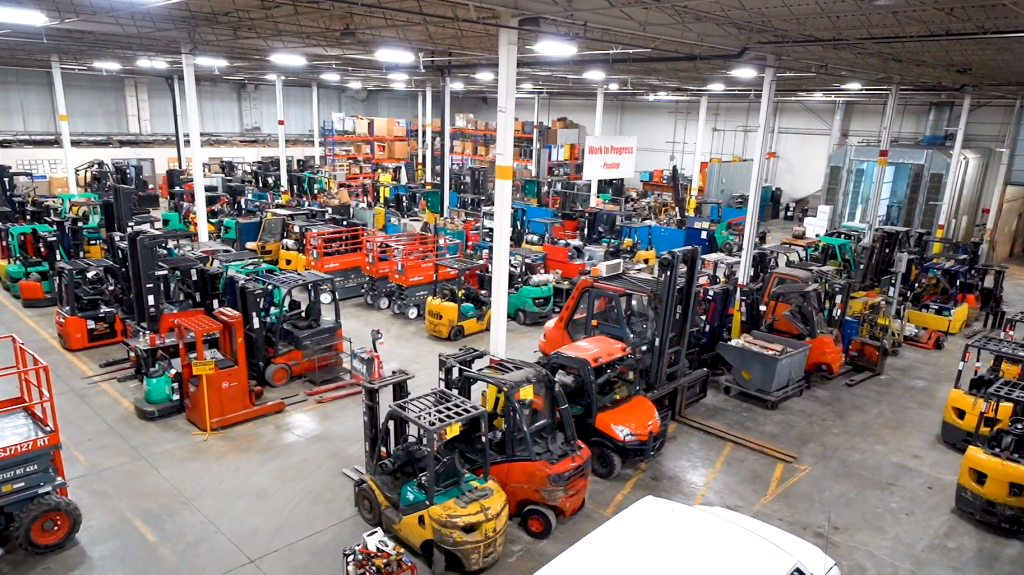
You can see the forklift in person if you purchase from a local dealership.
Now that you know the important things to consider when buying a new or used forklift, the next step is deciding where to buy it. There are three main options:
- Buying online from industrial equipment sales websites
- Buying from individual companies selling their forklifts
- Working directly with a dealership
Let’s look at each option to help you decide which one works best for you.
Buying Online from Equipment Sales Websites
Many websites specialize in selling industrial equipment. Online websites give you many choices. Some popular Canadian sites for buying forklifts include:
- MachineryTrader.ca
- Kijiji.ca (Industrial Equipment section)
- Ritchie Bros. Auctioneers (Rbauction.com)
These sites usually list forklifts from dealers who want to reach more buyers. Buying online lets you see a wider selection than what is available locally. This can help if you need a special or rare forklift model.
Advantages:
- You may get more variety from all over the country.
- You may have a better chance to find specific or unique models.
Disadvantages:
- You may not know the seller well.
- You usually cannot inspect the forklift in person, only through photos or videos.
- Shipping from far away can be very expensive.
Buying from Individual Companies
Another option is to buy forklifts directly from companies selling their equipment. For example, businesses that are closing might sell their forklifts, or liquidation firms might have them in stock.
Advantages:
- Prices may be lower because sellers want to sell quickly.
- You might find bargains or deals.
Disadvantages:
- No service history or warranty is usually provided.
- There is a risk of hidden problems since you don’t get a professional inspection.
Buying from a Dealership
The last option is to buy from a local forklift dealer. As a dealer ourselves, we believe this is often the best choice. If you are near the GTA or Montreal, talk to your local Ri-Go Lift dealer.
Benefits of Buying from a Dealer:
- Inspect Before You Buy: You can see the forklift in person, check its condition, and even test it. This helps you be sure it fits your needs.
- After-Sales Support: Dealers usually offer warranties and repair services. If something goes wrong, you can get professional help quickly.
- Professional Sourcing: Dealers can find specific forklifts for you, fix them up if needed, and deliver them ready to use. This saves you from dealing with complicated shipping or repairs.
- Expert Advice: Sales teams can visit your workplace, understand your needs, and help you pick the right forklift. This can prevent costly mistakes and make the buying process easier.
Making Your Decision
Where you buy your forklift depends on what matters most to you.
- Online websites give you many choices. These sites offer a wide selection across Canada and can help you find specific models.
- Individual sellers might offer lower prices, but there is more risk involved.
- Dealerships provide peace of mind with warranties, after-sales support, and expert advice. They can also help source forklifts that match your exact needs.
Each option has its benefits, but we recommend working with factory-authorized dealerships like Ri-Go Lift for a reliable and hassle-free experience.
If you are near Toronto, the GTA, or Montreal, contact your local Ri-Go Lift dealer to find the right forklift for you.
Looking for a Forklift Dealer You Can Trust? Contact Ri-Go Lift
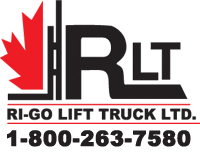
Since 1977, Ri-Go Lift Truck has been serving customers in Ontario and Quebec with everything they need for material handling. We are committed to providing you with quality service and a high level of customer satisfaction.
We are your authorized dealer for the following top brands:
- Linde Lift Trucks, Power Pallet Trucks, Tow Tractors and Stackers
- Hangcha Forklifts Full Lineup of Electric & IC Equipment
- Blue Giant Lift Trucks and Pallet Movers
- Komatsu Forklifts and Reach Trucks
- Mariotti Lift Trucks – The World’s Smallest Lift Truck
- Baoli Lift Trucks
- Advance Sweepers and Scrubbers
- Skyjack Genie Booms and Scissor Lifts

In addition to our authorized distributorships, we can also provide you with:
- Large selection of used forklifts
- Operator Training Department – open 7 days a week
- Parts Departments – over 1.4 million dollars of parts on hand for all makes and models
- Service Department – highly trained technicians
- Leasing and Rentals
No matter what your material handling needs are, we can help. Contact us today to let us know how we can be of service.



